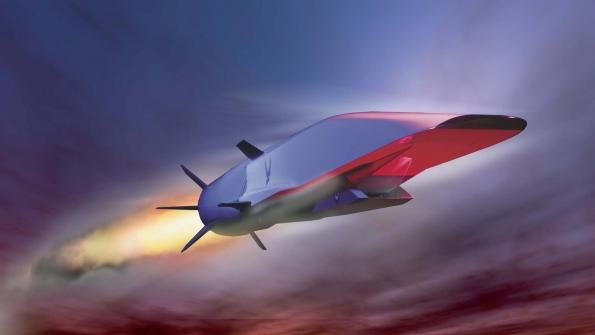
LOS ANGELES—Lockheed Martin has extended its long-running hypersonic links with Aerojet Rocketdyne by selecting the rocket and scramjet maker to provide a solid-fuel booster for the company’s new Mach 5-plus air-launched, standoff missile in development under the U.S. Air Force Hypersonic Conventional Strike Weapon (HCSW) program.
The rocket maker, which has been part of Lockheed’s air-breathing hypersonic propulsion concept studies since the mid-2000s, also worked from around the same period with Lockheed on a modified Army Tactical Missile System solid motor to boost the Boeing-developed X-51A Waverider. The hypersonic vehicle was powered by a scramjet developed by Rocketdyne, then under the ownership of Pratt & Whitney.
Aerojet paved the way for potential applications on several hypersonic weapons in 2018 by completing hot fire tests of an advanced tactical booster developed under an Air Force Research Laboratory (AFRL) contract. The tests mimicked extreme cold and hot-soak conditions for air-launch applications and proved the viability of the booster for use on upcoming systems such as HCSW, which is expected to be flight tested at the end of 2020.
The HCSW is one of several new hypersonic glide vehicle (HGV)-based weapons on the cusp of entering flight testing. In June the Air Force conducted the first captive-carry test flight of the DARPA/Air Force Research Laboratory-developed Tactical Boost Glide (TBG) hypersonic demonstrator, a Lockheed-built prototype to the company’s follow-on AGM-183A Air Launched Rapid Response Weapon, or ARRW. Raytheon is also developing an HGV under the TBG effort as well as a follow-on ARRW variant.
Boosters will also will be required for the follow-on DARPA/Air Force air-launched, scramjet-powered Hypersonic Air-breathing Weapon Concept (HAWC). For this Aerojet is already teamed with Lockheed to develop the scramjet for the program, which the research agency began with AFRL in 2014.
In June 2019, Raytheon also revealed it was partnered with Northrop Grumman under a competing HAWC contract with DARPA. Both variants are expected to enter flight testing by the end of 2020.





